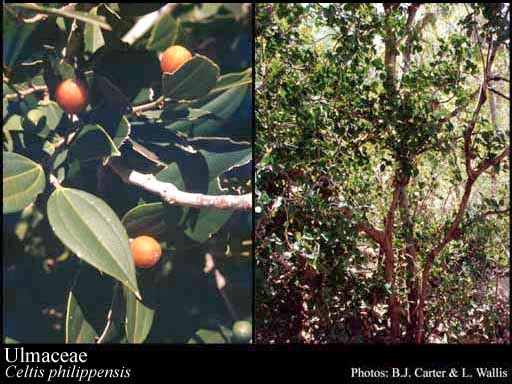- Reference
- Elém.Physiol.Vég.Bot. 2:905 (1815)
- Name Status
- Current







Scientific Description
Common name. Elm Family.
Habit and leaf form. Trees and shrubs; evergreen, or deciduous; leptocaul. Mesophytic. Leaves alternate; spiral, or distichous; petiolate; non-sheathing; simple. Leaf blades entire; pinnately veined, or palmately veined (then with three main veins— Celtidoideae); cross-venulate; often oblique at the base. Leaves with stipules. Stipules interpetiolar, or intrapetiolar; free of one another, or concrescent; caducous. Leaf blade margins entire, or dentate (or lobulate). Vegetative buds scaly. Leaves without a persistent basal meristem. Domatia recorded (3 genera); represented by pockets, or hair tufts. Stem anatomy. Nodes tri-lacunar. Secondary thickening developing from a conventional cambial ring.
Reproductive type, pollination. Fertile flowers hermaphrodite, or functionally male and functionally female, or hermaphrodite, functionally male, and functionally female. Unisexual flowers present, or absent. Plants hermaphrodite, or monoecious, or polygamomonoecious. Male flowers with pistillodes. Entomophilous.
Inflorescence and flower features. Flowers solitary, or aggregated in ‘inflorescences’; in cymes, or in fascicles. The terminal inflorescence unit cymose, or racemose. Inflorescences axillary; usually cymose clusters. Flowers small; regular, or somewhat irregular; cyclic. Free hypanthium present (or arguably so, when stamens are inserted on the perianth), or absent. Hypogynous disk absent. Perianth sepaline; (2–)5(–9); 1 -whorled (ostensibly), or 2 -whorled (?—theoretically); free, or joined. Calyx (if the perianth is so interpreted (2–)5(–9); 1 -whorled, or 2 -whorled; polysepalous, or gamosepalous; imbricate, or valvate (sometimes induplicate-valvate); unequal but not bilabiate, or regular; persistent. Androecium present, or absent (sometimes, from male flowers). Fertile stamens present, or absent (in female flowers). Androecium (2–)4–8(–15) (mostly equalling or twice K). Androecial members adnate (to the bottom of the perianth), or free of the perianth; free of one another; 1 -whorled, or 2 -whorled. Androecium exclusively of fertile stamens. Stamens (2–)4–8(–15); reduced in number relative to the adjacent perianth, or isomerous with the perianth; oppositisepalous; erect in bud (nearly always), or inflexed in bud (sometimes, in Celtis). Anthers dorsifixed; dehiscing via longitudinal slits; extrorse, or introrse; tetrasporangiate. Fertile gynoecium present, or absent (male flowers). Gynoecium 2(–3) carpelled. The pistil 1 celled, or 2 celled. Carpels reduced in number relative to the perianth. Gynoecium syncarpous; synovarious to eu-syncarpous; superior. Ovary unilocular, or plurilocular; 1 locular (usually, by abortion), or 2 locular. Gynoecium median; stylate, or non-stylate to stylate. Styles 1–2; free to partially joined; apical. Stigmas 1; dry type; papillate; Group II type. Placentation apical. Ovules in the single cavity 1; pendulous; non-arillate; anatropous, or campylotropous (Celtidoideae).
Fruit and seed features. Fruit fleshy, or non-fleshy; indehiscent; a samara, or a nut, or a drupe. Seeds scantily endospermic, or non-endospermic (usually). Cotyledons 2. Embryo achlorophyllous (2/5); straight (Ulmoideae), or curved (Celtidoideae). Seedling. Germination phanerocotylar.
Physiology, biochemistry. Nitrogen-fixing root nodules present (Parasponia), or absent. Aluminium accumulation not found. Photosynthetic pathway: C3.
Geography, cytology, number of species. World distribution: widespread tropical and temperate. X = 10, 11, 14. 200 species.
Economic uses, etc. Timber (especially for furniture) from Ulmus (elm), Planera (false sandalwood).